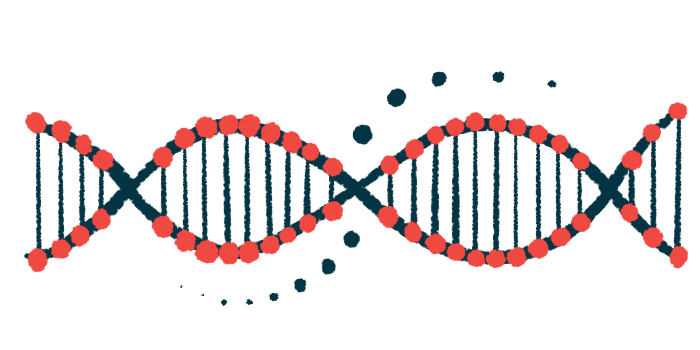DNA repair genes contribute to Huntington’s, mouse study suggests
Deleting two of these genes in mice slowed rate of CAG repeat expansion
Written by |

Specific genes involved in repairing mismatched DNA contribute to the development of Huntington’s disease by driving fast somatic CAG repeat expansion — a phenomenon in which Huntington’s-causing mutations grow, or expand, during a person’s lifetime, scientists report.
Their study, done in a mouse model of Huntington’s, showed that targeting these genes prevented further somatic CAG repeat expansion and the formation of the mutant huntingtin protein clumps that ultimately drive neurodegeneration.
These benefits were seen in specific nerve cells of the striatum, a brain region profoundly affected by Huntington’s.
“We were surprised to see the potent and sustained effects of targeting these mismatch repair genes in HD [Huntington’s disease] mice — the benefit lasts up to 20 months of age in a mouse, which would be comparable to about 60 years in humans,” Xiangdong William Yang, MD, PhD, the study’s senior author at UCLA Health, the healthcare system affiliated with the University of California, Los Angeles, said in a UCLA Health news release.
Genetic modifiers act to promote or lessen a disease’s severity
“Our study suggests that these genes are not just disease modifiers, as suggested by the previous studies, but are genetic drivers of Huntington’s disease,” added Yang, a professor in UCLA Health’s department of psychiatry and biobehavioral sciences.
Genetic modifiers are genetic variants that do not cause disease themselves, but influence the effects of a disease-causing gene, worsening or lessening disease severity.
Findings in this study — “Distinct mismatch-repair complex genes set neuronal CAG-repeat expansion rate to drive selective pathogenesis in HD mice” — imply that blocking the activity of certain DNA repair genes may help to prevent Huntington’s-associated neurodegeneration, the researchers noted. It was published in Cell.
Huntington’s is caused by excessive repetition of a trio of nucleotides (DNA’s building blocks) — a cytosine (C), an adenine (A), and a guanine (G) — in the HTT gene. This repetition — a kind of genetic stutter, the release notes — leads to the production of an abnormally long version of the huntingtin protein that toxically clumps in nerve cells, also called neurons.
CAG repeat expansions are not stable, and they can progressively lengthen over the course of a person’s lifetime (somatic CAG repeat expansion). These somatic expansions are believed to contribute to disease onset and progression, with longer CAG repeats being associated with earlier onset and more severe disease.
Previous studies suggested that DNA mismatch repair genes may act as genetic modifiers in Huntington’s.
DNA is a molecule containing two strands, wrapped around each other in a widely known, double-helix shape. Normally, each nucleotide on one strand of the DNA molecule matches up with another specific nucleotide on the adjoining strand.
During DNA duplication, the wrong nucleotides are sometimes added to the newly formed DNA strand, creating a DNA mismatch with the adjoining, original strand. DNA mismatch repair genes, as the name implies, normally help to correct this type of DNA damage.
Deleting one repair gene copy cut monthly CAG repeat rate from 9 to 2
Researchers performed a series of experiments where they deleted specific DNA mismatch repair genes in a mouse model of Huntington’s. In this model, brain cells that are most affected by Huntington’s in humans show disease features, including CAG repeat expansions and toxic huntingtin clumps.
Data showed that deleting two of the six tested genes — Msh3 and Pms1 — strongly rescued these abnormalities. Also, Msh3-deficient mice showed sustained improvements in terms of neurons, neuron-supporting cells, and motor functions relative to the unaltered Huntington’s mouse model.
Experiments in spiny neurons in the striatum, the nerve cells most vulnerable to Huntington’s, showed that the observed benefits with Msh3 or Pms1 deletion were associated with slower rates of somatic CAG expansions.
Specifically, while these neurons usually expanded at a rate of nearly nine additional CAG repeats per month, deleting one copy of the Msh3 gene reduced that monthly rate to about two additional repeats, and deleting both Msh3 copies nearly prevented further expansion, with less than one CAG repeat being added per month.
Further analyses showed that lacking the resulting Msh3 or Pms1 proteins prevented the formation of toxic huntingtin clumps in spiny neurons by keeping CAG length below 150.
Work indicating that select DNA repair genes can drive repeat expansion
Data suggest that these genes don’t just modify Huntington’s progression, but actually help to drive the disease.
“We demonstrate the same DNA mismatch repair genes that are modifiers in the Huntington’s disease patients can drive fast-paced disease processes only in the most vulnerable neurons in a mouse model, leading to a cascade of disease [features],” Yang said. “Our study provides mechanistic links that help to bridge modifier genes from patients, mismatch repair gene driven repeat expansion, and selective neuronal vulnerability in HD.”
While the mechanisms still aren’t completely understood, “our study provides important implications for therapeutic development for HD and related repeat expansion disorders,” the researchers wrote.
Blocking the activity of mismatch repair genes, especially Msh3 and Pms1, may help to prevent the nerve damage that drives Huntington’s, the team concluded. Still, the scientists noted that further work is needed to understand exactly how these genes become dysregulated to drive disease.
Work in this study was supported by funds from the CDHI Foundation and grants from the National Institutes of Health.





